Looking for ways to give a splash of color to your room with flora? Red Leaf Indoor Plants are just the right thing!
Plants exhibit the liveliest vibes indoors, and when it comes to vibrant shades, these Top Red Leaf Indoor Plants are not worth missing out on! Pick your favorite from the list compiled below!
Look at the Best Pothos Varieties here
Top Red Leaf Indoor Plants
1. Red-Marginated Dracaena
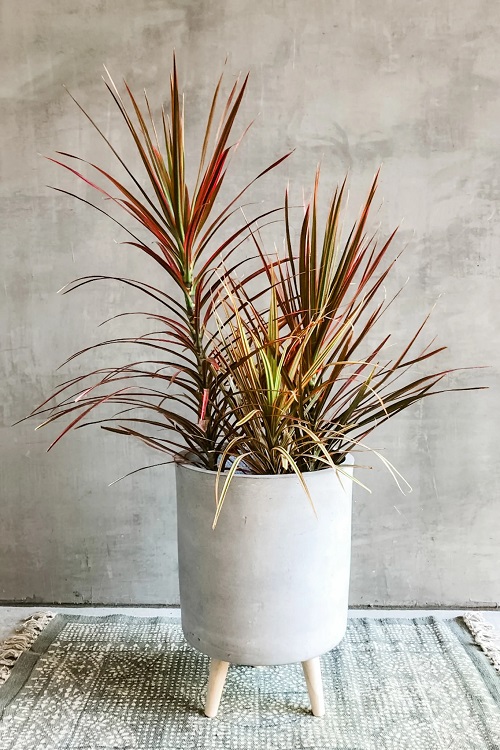
Botanical Name: Dracaena marginata
USDA Zones: 10 – 12
Originating from Madagascar and Mauritius in East Africa and commonly known as Dragon Tree, this perennial evergreen plant has green leaves with red edges, which gives the plant an overall mixed shade of the two colors. The plant can be grown as a houseplant with medium maintenance.
Growing Tip: This plant needs less water, so keep them hydrated by misting the leaves.
Check out the Best Hota Varieties here
2. Red-Veined Prayer Plant

Botanical Name: Maranta leuconeura
USDA Zones: 11
Native to Brazil, this perennial plant has leaves with red undersides. The variegated leaves fold at night to look like praying hands, hence the name. It grows well in a temperate climate as a container plant or a houseplant and is tolerant to heat and humidity.
Growing Tip: For this plant to thrive, avoid intense, direct sun.
3. Arrowhead Plant
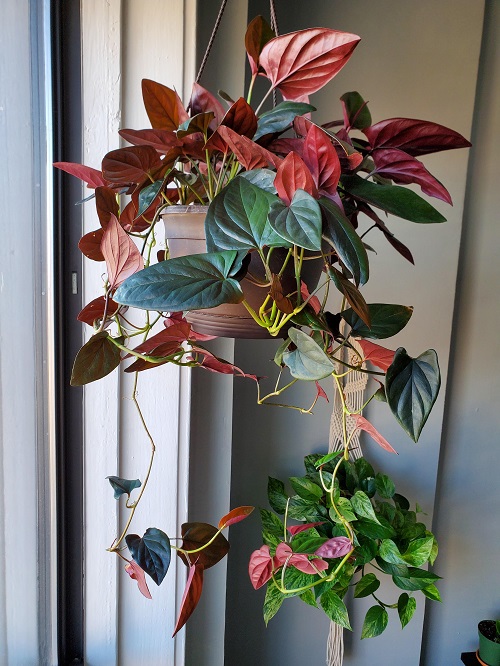
Botanical Name: Syngonium podophyllum ‘Red Heart’
USDA Zones: 10 – 12
The dusty red heart-shaped variety of Syngonium wins many hearts with its low care needs. This perennial herbaceous plant has showy leaves which thrive in humid and warm conditions and grow as a vine.
Growing Tip: Allow soil to dry out halfway between waterings.
4. Begonia Rex – Red Kiss
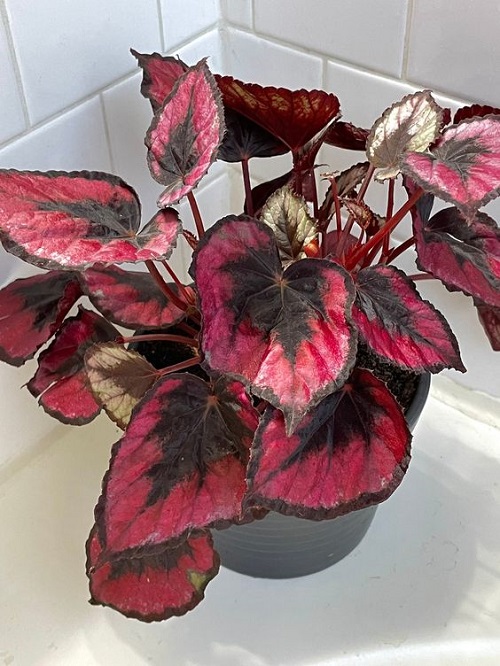
Botanical Name: Begonia rex
USDA Zones: 10 – 11
The deep red variant of the Begonias is a sight to behold. Begonias are commonly used as houseplants for their striking foliage. It is a perennial plant having waxy leaves and grows best in bright indirect sunlight.
Growing Tip: Water this plant weekly for good growth.
5. Red Coleus

Botanical Name: Coleus scutellarioides
USDA Zones: 10 – 11
Native to Asia and Africa, this perennial herbaceous plant belongs to the mint family. The variegated leaves come in red, purple, and burgundy shades. It is easy to care for it as a houseplant, growing well in bright light.
Growing Tip: Soil that is too damp can lead to diseases, so plant it in rich, loose soil.
6. Red Peperomia
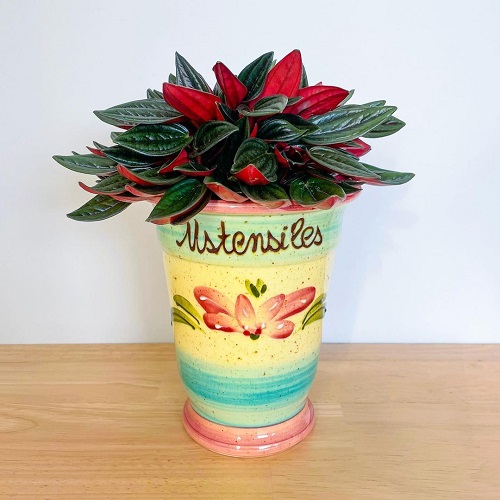
Botanical Name: Peperomia caperata
USDA Zones: 11 – 12
Hailing from Brazil, this evergreen perennial houseplant thrives in temperate climates. It has bushy growth habits and can grow upto 8 inches. The wrinkled leaves are colored dark red or green and can grow even in prolonged deep shade.
Growing Tip: This plant does not require too much water. You only need to water them when the soil is dry.
7. Red Nerve Plant
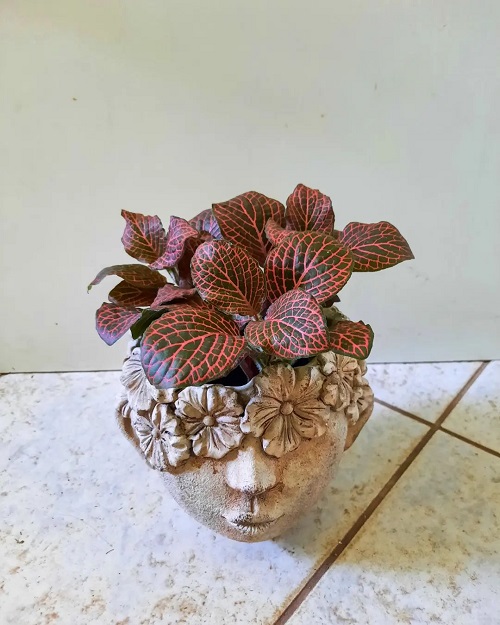
Botanical Name: Fittonia albivenis
USDA Zones: 11 – 12
Popular as Red Nerve Plant, due to the deeply veined leaves, this is a herbaceous perennial plant. Its attractive foliage popularized it as a houseplant that can be propagated easily by stem cuttings and grown in a container or a hanging basket.
Growing Tip: This plant grows well in moist soil. Water this plant regularly to keep your potting soil moist.
8. Croton
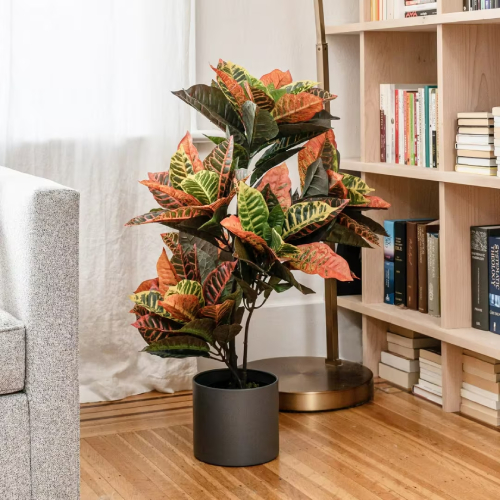
Botanical Name: Codiaeum variegatum
USDA Zones: 11 – 12
Croton is a stunning tropical indoor plant with beautiful and variegated foliage. Its unique and eye-catching appearance and hardy characteristics make it a favorite of many plant lovers. Low maintenance requirements make it an ideal choice for busy homeowners.
Growing Tip: Place croton in a sunny location such as an eastern, southern, or western window.
9. Red-leaf Philodendron
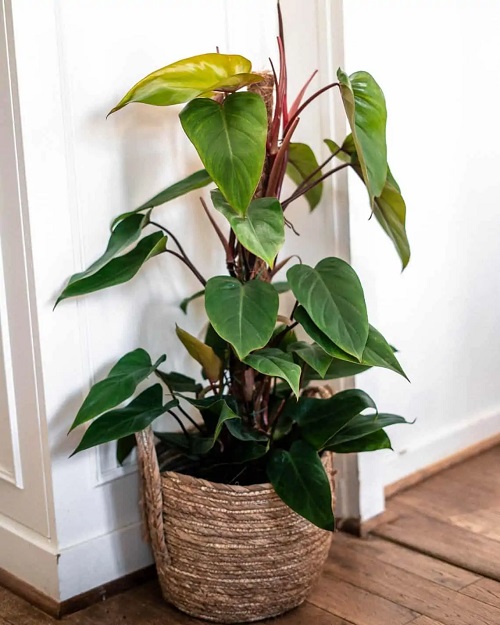
Botanical Name: Philodendron erubescens
USDA Zones: 10 – 11
This variety of Philodendron is native to Colombia and Costa Rica and grown as a houseplant for its ornamental red-green foliage, which turns purple as it matures. Keep misting the plant regularly to ensure that it thrives. It is one of the Top Red Leaf Indoor Plants on this list.
Growing Tip: This plant grows best in medium light and bright indirect sunlight.
10. Red-Painted Calathea
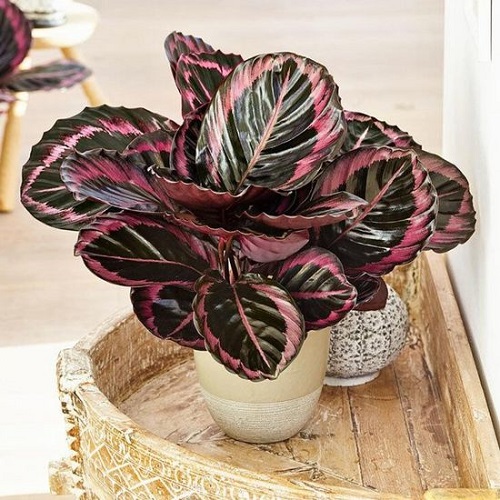
Botanical Name: Calathea roseopicta
USDA Zone: 11 – 12
The Rose-painted Calathea is a member of the Prayer Plant family. Since it is adapted to grow in the rainforests of Brazil, it is also called the Jungle Rose. It grows well in well-drained and wet chalk, clay, or loamy soil. Keep the soil moist and water as per the climate.
Growing Tip: This plant thrives with high humidity levels. Mist your prayer plants regularly.
11. Chinese Evergreen – Siam Aurora
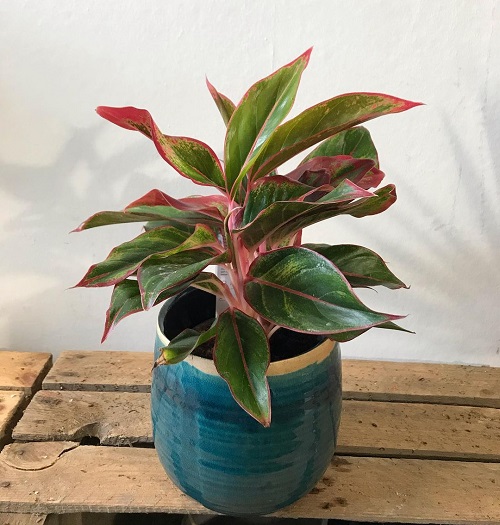
Botanical Name: Aglaonema
USDA Zones: 10 – 11
Also known as Red Aglaonema, this herbaceous plant is planted as a houseplant for its striking leaves and vibrant look. The elliptic leaves with pointed tips are red along the margins, and veins combined with dark green throughout.
Growing Tip: Use well-draining soil with lots of organic matter for this plant.
12. Poinsettia

Botanical Name: Euphorbia pulcherrima
USDA Zones: 9 – 11
Poinsettias are sheer beauty if you are a fan of bright red foliar specimens. Also, it comes in a number of textures and variegation. While growing indoors, they make for pretty cut flowers, making them popular during festive seasons as decorative and gift items.
Growing Tip: Trim the plant after regular intervals and move it into full sun for good growth.
Find the Best Indoor Japanese Plants here
13. Caladium

Botanical Name: Caladium
USDA Zones: 9 – 11
Caladiums are noted for the bright red splash in the center, bordered by wide green patches. The large foliage on slender stalks creates a statement wherever they are placed. Caladium grows well in hot, humid weather, making it a great indoor option.
Growing Tip: Keep the soil moist for this plant, or its leaves may turn yellow and fall.
14. Bromeliad

Botanical Name: Bromeliaceae
USDA Zones: 9 – 10
Bromeliad is an easy-to-care tropical-looking plant that grows under average home conditions. It is known for providing an array of stunning colors and textures. As an epiphyte, bromeliads can cling to trees or be planted in shallow soil without investing much effort in the growing medium.
Growing Tip: Although the plant needs bright light, avoid direct sun exposure.
15. Anthurium
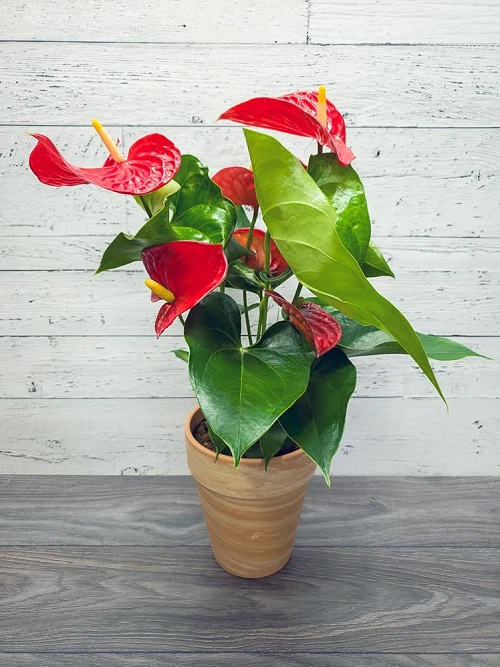
Botanical Name: Anthurium
USDA Zone: 11 to 12
One of the Top Red Leaf Indoor Plants—Anthurium, is noted for the glossy bright red spathe that makes the houseplant a sheer stunner! The central rod-like spadix bears numerous tiny bisexual flowers, adding to its charm. These grow well in warm temperatures and high humidity of indoors.
Growing Tip: Fertilize Anthurium with a houseplant fertilizer high in phosphorus.
16. Ti Plant
Botanical Name: Cordyline fruticosa
USDA Zones: 10 -13
Ti Plant has a palm-like structure that grows considerably but can be trained to a shorter height indoors. It has an attractive fan-like and spirally arranged cluster of leaves that are red to green. This plant produces long panicles of small scented yellowish-to-red flowers that mature into red berries.
Growing Tips: During cold months, water this plant less frequently.
17. Polka Dot Plant
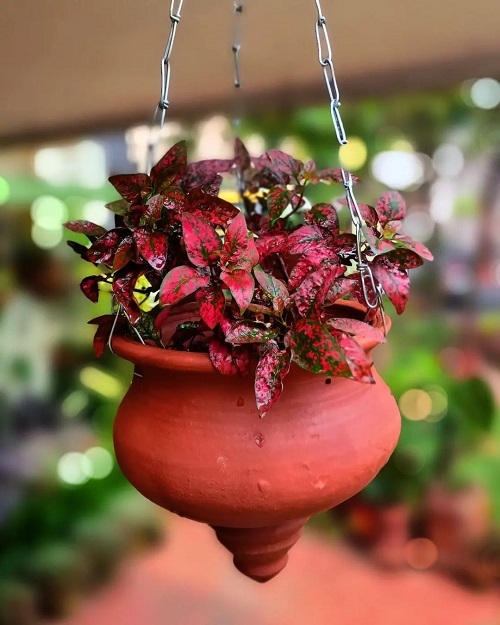
Botanical Name: Hypoestes phyllostachya
USDA Zones: 10 to 11
Native to South Africa, Madagascar, and South East Asia, the Polka dot plant is a popular house plant because of its colorful red foliage. This plant produces various colors and types of leaf spotting and grows well under indirect light. However, it exhibits the best colors in lower-light conditions.
Growing Tip: Don’t forget to prune this plant for good growth.
18. Pencil Cactus

Botanical Name: Euphorbia tirucalli
USDA Zones: 11-12
The pencil cactus is a shrub with succulent foliage that can grow up to 30 feet tall and 6-10 feet wide in the wild and 2-6 feet tall indoors. This plant is known for its thick brown branches with clusters of smaller green branches at their ends, and its oval leaves turn red indoors, making it one of the Top Red Leaf Indoor Plants you’ll come across.
Growing Tip: It only needs water every two to three weeks in the spring and summer. Prune this plant for good growth.
Check out the Best Indoor Succulents here
19. Red Star Dracaena
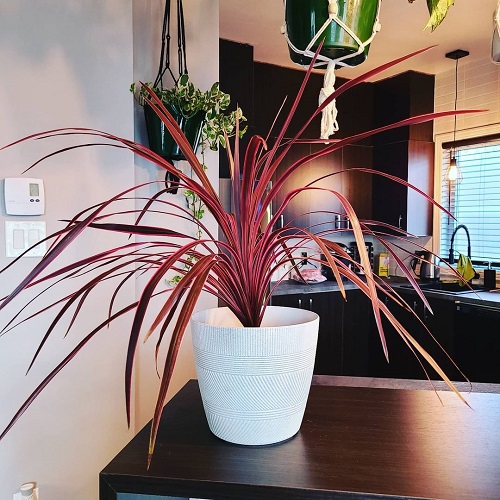
Botanical Name: Cordyline australis ‘Red Star’
USDA Zones: 7 to 11
This plant is known for its long tropical dark red foliage and is very popular as a container plant due to its height and texture. If you want this plant to maintain its color, ensure it gets good light. The dark red sword-like leaves give an amazing display indoors. These grow well under full sun and well-drained soil.
Growing Tip: If you live in colder areas, avoid keeping the plant outside the house during winter.
20. Heuchera

Botanical Name: Heuchera americana
USDA Zones: 4 – 9
Heuchera is also called coral bells or alumroot, which grows in dry locations. It has a 12 to15 inches tall basal clump of heart-shaped leaves with purplish-brown and red hues. Its attractive foliage and airy flower panicles provide a contrasting look indoors.
Growing Tip: Grow this plant in organically rich, medium moisture, well-drained soils under full sun to partial shade.
21. Herbst’s Bloodleaf
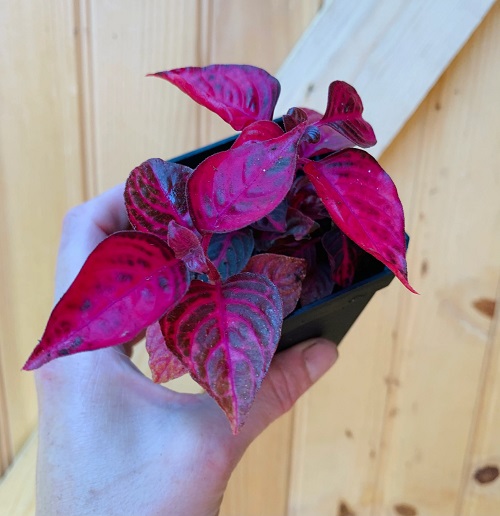
Botanical Name: Iresine herbstii
USDA Zones: 10 – 11
As the name suggests, this plant is painted in a bright red hue and has deep red veins. The showy makes it a beautiful indoor plant, especially for the dull corners of the house. Also, this red-leaf houseplant is endowed with several medicinal benefits.
Growing Tip: It grows well in organic-rich and well-drained soil. Adding fertilizer every two weeks will make this plant flourish.
22. Earth Star Plant
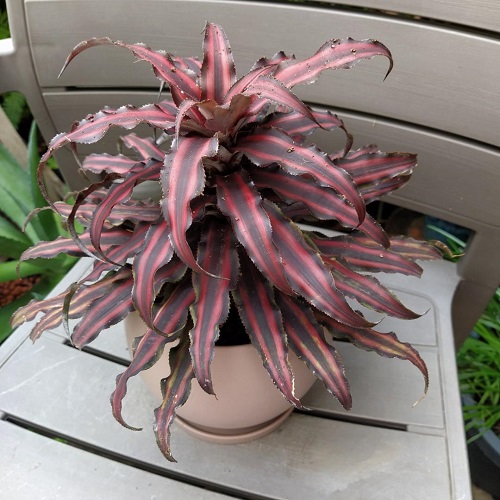
Botanical name: Cryptanthus bivittatus
USDA Zones: 10 – 11
The interesting foliage shapes have popularized this gorgeous specimen by the name —Earth star. The leaves come in a range of colors, including red. These plants occur naturally on rainforest floors and grow well in similar low-light conditions indoors
Growing Tip: Earth Star plants grow best in soil that can maintain high moisture levels but avoid overwatering.







